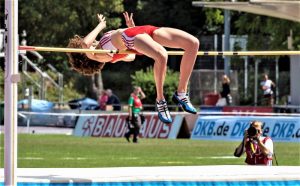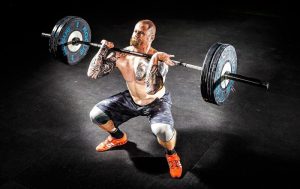High jump
The high jump is a sporting event that takes place in the competitions of the Olympic program. It is a sport that belongs to athletics, in which the athlete makes a jump preceded by a race to reach the height. The headquarters of the sport includes a semicircular track that allows an approach race from any angle. Two rigid vertical supports hold a horizontal light transversal bar in such a way that it will fall if it is touched by a competitor who tries to jump over it.
What is high jump?
The high jump is a branch of athletics in the category of field events, which is based on being able to surpass the bar that has been placed at a certain height, jump that is done after gaining momentum through a race and a takeoff.
What does the high jump consist of?
The high jump consists of performing a vertical jump to try to overcome a bar or ribbon as it is also known, without knocking it down, which in turn can be placed at different heights. This jump is done after the athlete has made a run and an impulse takeoff and is a sport that is usually practiced by both men and women.
Characteristics
The main characteristics of the high jump are the following:
- The high jump consists of four different moments for its execution, which include the impulse race, the takeoff, the flight and the fall.
- The take-off must be performed with only one leg.
- The positions for jumps are known as variants.
- The sport is present within the Olympic Games held in Greece in 1896.
- Women made their debut in this discipline at the Olympic Games in Amsterdam in 1928.
- The bar is raised after each jump.
- The bar or ribbon is a stick made of wood or can also be a metal
History of high jump
High jump competitions were very popular in Scotland at the beginning of the 19th century, although according to historians, sport has records since 776 BC, and there is some evidence that it was practiced in Asia and Egypt. The event was incorporated into the first modern Olympic Games in 1896. Of all the field events, the high jump is probably the one that has undergone the most radical changes in technique. The Cretans also practiced big high jumps and hammer throwing.
Rules
The main rules that must be followed when practicing high jump are the following:
- An athlete can approach the bar from any angle and can take off using only one foot.
- Before the competition, the chief judge will announce the start.
- The bar may never be raised by less than 2 cm or 3 cm in combined events.
- An athlete can start jumping at any height that has been previously announced.
- Three consecutive failures regardless of height will cause the elimination of the athlete.
- A jump is void when the athlete knocks down the bar or touches the ground beyond the vertical plane of the jump meter.
- Each athlete has three jump attempts for each height.
- All athletes have a maximum time to perform the jump.
- The athlete who manages to jump the maximum height
Technique
In the high jump sport, there are two techniques that are considered the main ones, and these are the Fosbury style and the ventral roller style:
- Fosbury style: in this technique, the athlete must run towards the transversal bar, following a curved trajectory, and when he or she is able to jump backwards in front of the ribbon, he or she must place the next extended arm. From a biomechanical point of view, this technique is considered the most effective because it allows the jumper to gain more height.
- Ventral roller: this technique is considered the simplest to perform. A diagonal should be made on the side of the beaten leg, the ribbon should be passed to the front. When the bar is passed on the roller, the beat leg must be in a flex position to avoid hitting the bar.
Phases of high jump
The phases of the high jump depend on the technique being performed and are as follows:
Fosbury style
- Race: The objective is to achieve horizontal speed, to reach an optimal acceleration in which the jumper can control in the moment of carrying out the beat, transforming it into vertical speed.
- Jump: Period of time from the moment the jumping foot touches the ground to the moment it abandons it at take-off, at this point it takes advantage of the kinetic energy gained in the horizontal race, transforming it into vertical speed.
- Flight: It starts when the impulse foot is removed from the ground and ends when the head and shoulders are above the ribbon.
Ventral roller
- Race phase: It is done in an oblique direction to the bar, approximately between 7 and 9 steps. When the last three steps are taken, the body’s gravity center is delayed, slightly flexing the legs to be able to throw the jumping leg.
- Beat phase: It is done in an explosive way, in the direction of the bar. At the same time, the arms perform an upward action, so that, the body can be placed in the air, parallel to the bar.
- Reception phase: It is carried out when it falls on the shoulder that is furthest from the bar at the time of the beat and the athlete ends up rolling on the mattress.
Equipment
The high jump equipment consists of two jumping meters, the crossbar or ribbon, support plates and the fall mat.
Jumpers are the vertical posts that hold the crossbar or slat. Their constitution, shape or dimensions are not regulated; but it is stipulated that they are rigid and have a base that assures their correct position.
The transversal bar is placed horizontally and indicates the height to be crossed by the jumper. It may be made of fiberglass or other suitable material, but never of metal. Its transversal part is circular except in the ends. It has a length of between 3.98 m and 4.02 m and a maximum mass of 2 kg. The parts of the bar that are placed on the supports must be smooth and cannot be covered by any type of material.
The support plates are in charge of supporting the jumpers, they must be flat and rectangular in shape. Their measures are 40 mm high and 60 mm long. The supports cannot be covered by any type of material.
The fall zone is a rectangle with a minimum length of 5 meters and a minimum width of 3 meters. It must be covered by several weather-resistant mattresses and must be elastic.
How to cite this article?
Briceño V., Gabriela. (2019). High jump. Recovered on 3 May, 2025, de Euston96: https://www.euston96.com/en/high-jump/










